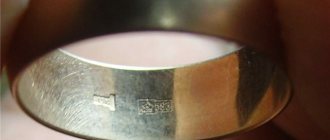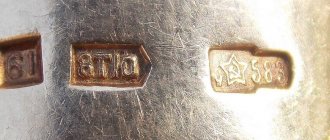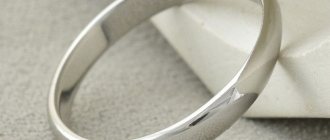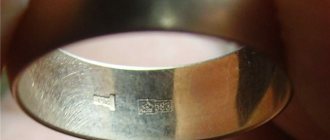What does a stamp on gold show?
The quality of the metal from which gold items sold or manufactured in the Russian Federation are made must correspond to one of the standards accepted by law and be certified by a stamp. If you want to buy a product made in another country in Russia, it may have not one mark, but two. Depending on the percentage of gold in the alloy, in the Russian Federation there are the following samples:
- 999 is pure gold, without the addition of any associated metals.
- 750 – 75.5% gold mixed with nickel, platinum and silver. This alloy can range in color from yellow to reddish. Since it is easy to process, it is used for the production of jewelry and more precise work.
- 585 is an alloy with 58.5% metals. This combination makes it ideal for production, as it becomes strong and dense.
- 500 - 50.5% gold mixed with silver and copper.
- 375 is an alloy containing 38% impurities of other metals. Color ranges from almost white to red. This alloy becomes dull after some time.
The method of its use depends on what type of sample is on the product. 999 gold is used in casting bars, 375 is used in dentistry, and the rest is used for making jewelry. Alloys with a breakdown level above 750 are not subject to tarnishing when exposed to air. For works of art, 958 is most suitable, for minting - 900, and for jewelry, 585 is actively used.
Only employees of the Assay Office can place a mark that confirms the sample of products, including those manufactured and imported from other countries. State territorial services brand not only gold, but also other metals that are produced in jewelry factories or workshops.
Thus, gold purity is a percentage designation of its impurities in the product. It looks like this: the sample shows a girl in a kokoshnik looking to the right, then the assay code and at the end the sample of the product, according to the standard.
The shape of the mark shows what kind of metal it is. For example, the mark on platinum products is an elongated octagon. Gold items have a mark in the shape of 2 blades. This new form has been used from 1994 to the present day.
Gold jewelry made during the Soviet era has a star-shaped mark.
Types of stamps
The shape of the imprint depends on the type of precious metal. On gold jewelry the mark has the shape of a spatula, on silver jewelry it is an oval cut off on the sides, and on platinum jewelry it is an elongated octagon. The print looks different in each country. Let me remind you that all products sold in the Russian Federation are subject to hallmarking at the local Assay Office. This means that I will talk about the types of Russian stamps.
Currently, the print depicts the profile of a girl in a kokoshnik. A similar design was on the stamps of the Russian Empire at the end of the 19th and beginning of the 20th centuries. Until 1896, the design looked like a “tee” in the form of the intersection of the hallmark numbers, year of manufacture, coat of arms, and letters. Soviet stamps depicted the head of a worker with a hammer (since 1927), a five-pointed star with a hammer and sickle (since 1958).
What is a name tag
Let's look at what a name tag is. Sometimes on jewelry you can find a master's mark, which is also called a name mark, but it does not prove quality.
The name tag refers more to the personal signature of some jeweler and the company that produced the item from the precious metal. If decrypted, it should contain additional information about it.
For an inexperienced buyer, the information included in the name plate will mean little. Only specialists or other jewelers will be able to tell with one glance at the personalized seal who made the jewelry, where and in what year. Since 1986, all jewelry manufacturers have been required to label them themselves.
After a year, the old name book must be destroyed. Its re-registration is carried out annually and differs from the previous one in the code of the year of manufacture. Many workshops can, at the customer’s request, put any inscription on gold jewelry. This could be either a word that is important to him or a date of birth or wedding. This is especially true for people who are planning to get married.
Determining the date and place of manufacture of a French silver item.
Determining the exact date of manufacture is quite difficult, because there are no special marks for this. A product can be identified over time by its style and characteristics. You can read about this in detail in the article - Characteristic features of various styles. And it is also possible to determine with high accuracy the time of manufacture of the product using the manufacturer’s marks. To do this, you need to use catalogs with examples of marks of different masters and compare them with what you have on the item. If the mark is discovered and the master is identified, it is enough to look at what period in the company’s activities the existing mark corresponds to. Typically, marks changed over time. The accuracy of the determinations in this case varies and can range from 5 to 15-20 years. The place of manufacture corresponds to the place of registration of the workshop, which can also be found in the corresponding catalogues.
Additional stamps, or name tags
The most famous jewelry factories and workshops receive the right to affix their own mark, called a name mark, to the items they produce. Today, the content of the name book is standardized and complies with the law. It consists of four letters:
- the first indicates the year of manufacture in alphabetical order, starting from 2000;
- the second serves as the code for the territorial department of the state inspection;
- the last two are the manufacturer’s code registered in the given territory.
The letters are placed in a contour approved by the regional inspection. Usually the name tag is placed next to the assay mark in the most inconspicuous place. The absence of marks on the product indicates that it was made illegally, that it is a crude fake or costume jewelry.
How to determine gold purity by the color of the alloy
The color of pure gold is bright yellow, but due to its softness, this metal in its pure form is not used to create jewelry. Jewelry is made from gold alloys, in which only part of the composition is allocated to gold. Ligatures (additives) make the connection harder, stronger, and give it different shades.
Based on the shade of the alloy from which the product is made, one can assume its sample. But this method of determining the composition is imperfect; only examination can accurately determine the percentage of gold and other metals.
Pink
This shade is characteristic of alloys containing silver and copper, in particular the following samples:
- 375: dark pink,
- 585: soft pink;
- 750: slightly pinkish.
White
If you see a piece of jewelry with a white tint, most likely it is 750-grade metal. 25% of the composition is occupied by silver and palladium or silver and nickel.
Green
- Dark green color is typical for 750 standard with the following composition: 75% gold, 15% silver, 6% copper, 4% cadmium.
- The pale green material is obtained when 23% copper and 2% cadmium are added to 75% gold.
- The yellow-green metal is most likely 750 fine, and 25% of the composition is silver.
Violet
Gold jewelry may have a purple tint if it is made from a 14-karat alloy that contains 25% aluminum or potassium. If the color is rather bluish, then with a high probability it is a composition of 46% noble metal and 54% rhodium, cobalt or indium.
Sources
- https://lombardyinfo.ru/stati/probirnoe-klejmo.html
- https://ZolotoMan.ru/proby/klejmo-na-zolote.html
- https://ToZoloto.ru/proba/klejmo-na-zolote.html
- https://zolotogid.ru/metally/sistema-oboznacheniya-proby-na-zolotyh-izdeliyah-i-pozolote/
- https://uvelir.info/articles/probirovanie-yuvelirnyih-izdelij-eto-dolzhen-znat-kazhdyij-probyi-klejma-imenniki/
- https://goldomania.ru/articles-2/hallmark_gold.html
- https://russam.ru/stati/o_juvelirnyh_izdelijah/p18881-kakie_byvajut_proby_zolota/
Important Details
There are three ways to apply impressions:
- impact - applied mechanically to the stamp matrix;
- electric spark - applied with special equipment, the contour is not completed;
- laser - applying an imprint using laser engraving.
In Russia, the metric system of gold and silver samples has been adopted. The fineness of the alloy determines its value - the more precious metal, the more expensive. The remaining components (copper, zinc, nickel) are used to give the alloy strength and wear resistance, as well as some color. The color of the alloy does not depend on the standard: for example, 585 gold can be red, yellow, white and other colors, depending on the combination of alloys used.
The law does not require the marking of jewelry weighing up to three grams. Therefore, if you suspect that you have been sold a counterfeit item due to the lack of a stamp, first weigh the jewelry.
Source: tdserebro.ru precious metals, assay supervision, silver
Most popular samples
Most jewelry is marked with the following hallmarks: 375, 500, 585, 750. 375 gold is considered low-grade. This product usually has a yellow or reddish tint and fades over time.
The middle group (500 and 585 samples) is the most popular. This ratio of precious metal and alloy in the alloy makes the item durable and durable without losing its external shine.
Jewelry of 750 standard is considered high quality. The alloy has a bright yellow color. Even in white gold, the golden yellow is clearly visible. The 750 alloy alloy usually contains other precious impurities - silver, palladium, platinum.
958 gold is rare. Such jewelry is soft and easy to deform. For minting coins, 900 standard is usually used.
When and how did the gold standard appear in the world?
Where did the first mark on gold appear?
The history of hallmarking gold products goes back more than 25 centuries. In the middle of the 6th century BC. In the ancient state of Lydia, the first stamp on gold appeared. State stamps were placed on gold coins in Lydia, which protected the population of the ancient kingdom from counterfeiting and fraud.
In the photo of an ancient Lydian coin, you can see figured imprints reminiscent of modern hallmarks on gold.
The first sample of gold in Russia
In Russia, the first gold sample, which indicated the amount (proportion) of pure gold in the product, appeared 400 years later than in other European countries. For example, gold assaying in France has been historically recorded since 1275, and in Britain since 1300.
Hallmarks in Russia indicating the share of precious metal appeared only in 1700 under Peter I. Gold coins from the time of Peter I consisted of 97-98 percent pure gold and 2-3 percent copper. In Russia, the first gold test had the shape of a double-headed eagle.
Royal hallmark of gold
After the reign of Peter the Great, the royal rulers provided great assistance in the development of the jewelry industry. The assistance of the Russian government was expressed in training craftsmen in all the intricacies of jewelry craft and in reducing assay duties.
In Tsarist Russia, jewelry craftsmen for more than 200 years produced a huge number of products that bear the royal hallmark of gold. Nowadays, these gold items, many of which are considered unique works of art, are called royal gold.
Deciphering the hallmark
The hallmark consists of two designations, which can be located either side by side or separately:
- the identification mark of our state is either a Soviet hammer and sickle in front and a star with five points in the background, which are still relevant as an assay mark, or a profile of a woman in a kokoshnik, turned to the right;
- sample sign.
Hallmark:
1 — Code of the State Assay Supervision Inspectorate 2 — Mark of the Assay Certificate 3 — Digital designation of the precious metal sample
Sketches of hallmarks on gold:
Sketches of an assay clamp for silver:
Testing systems
The most popular are metric and carat. I will talk about them and other existing sample measurement systems below. Their correspondence table looks like this:
| Metric | Carat | Zolotnikovaya | Lotovaya |
| 375 | 9 | 36 | 6 |
| 500 | 12 | 48 | 8 |
| 583, 585 | 14 | 56 | 9 |
| 750 | 18 | 72 | 12 |
| 1000 | 24 | 96 | 16 |
Carat
Used in the USA and European countries. The karat designation shows how many parts of pure gold are in 24 parts of the alloy. To convert a metric value to a carat value, you need to multiply it by 0.024.
Metric
The most popular system. Used in most countries of the world, including Russia since 1927. Shows how much gold is contained in 1000 units of the alloy.
Zolotnikovaya
Branding using the spool system was used in the Russian Empire, then in the Soviet Union until 1927. It is not currently used. The measurement was based on a pound consisting of 96 spools. Accordingly, the spool test shows how many units of gold contain 96 units of the alloy.
Lotovaya
This testing system is also from the past. It was used in the Middle Ages by Western European peoples - Celts, Germans, Scandinavians. Previously, the mass of the precious metal was calculated in marks, consisting of 16 lots. This test shows how many lots of gold are in one brand of alloy.











